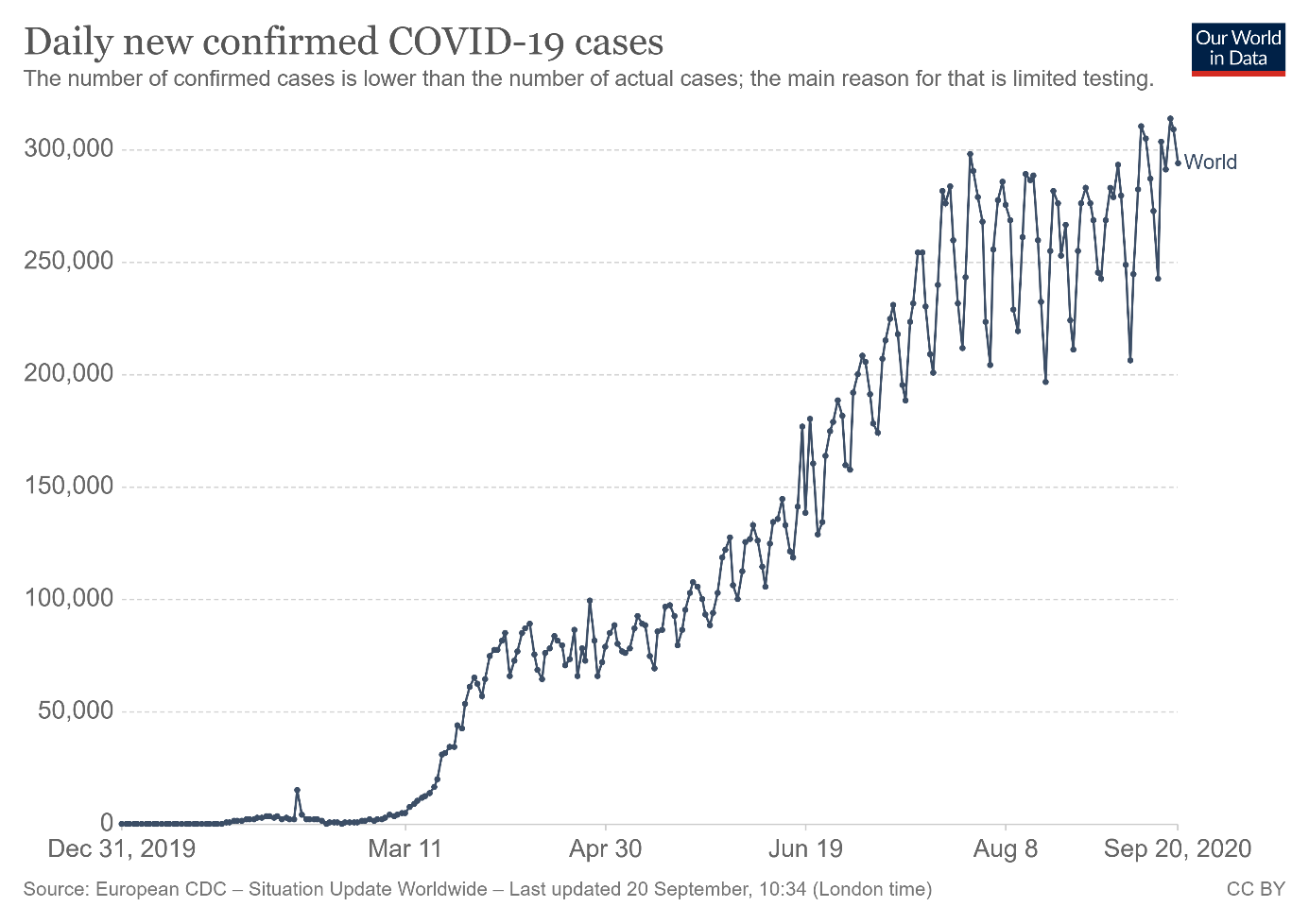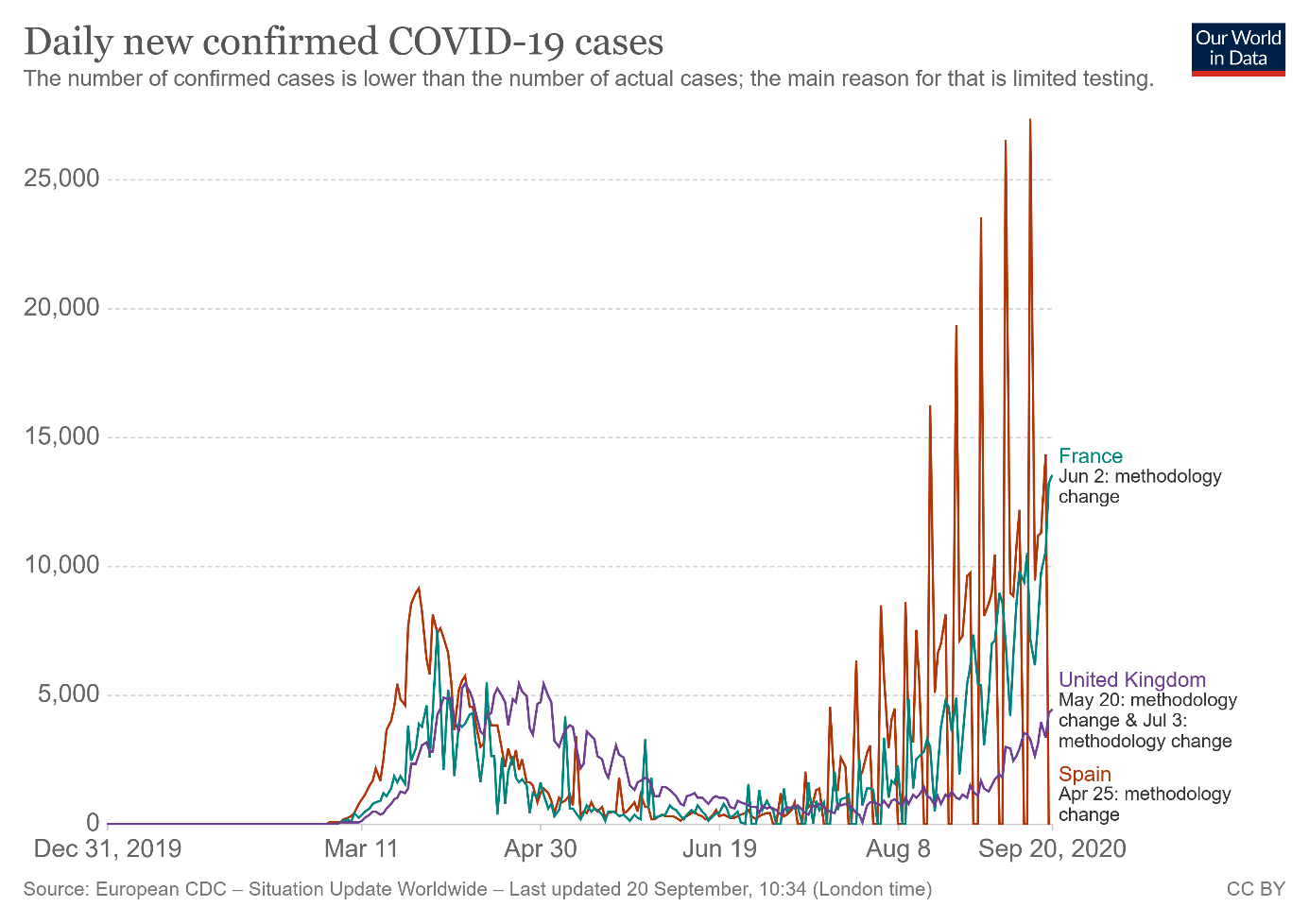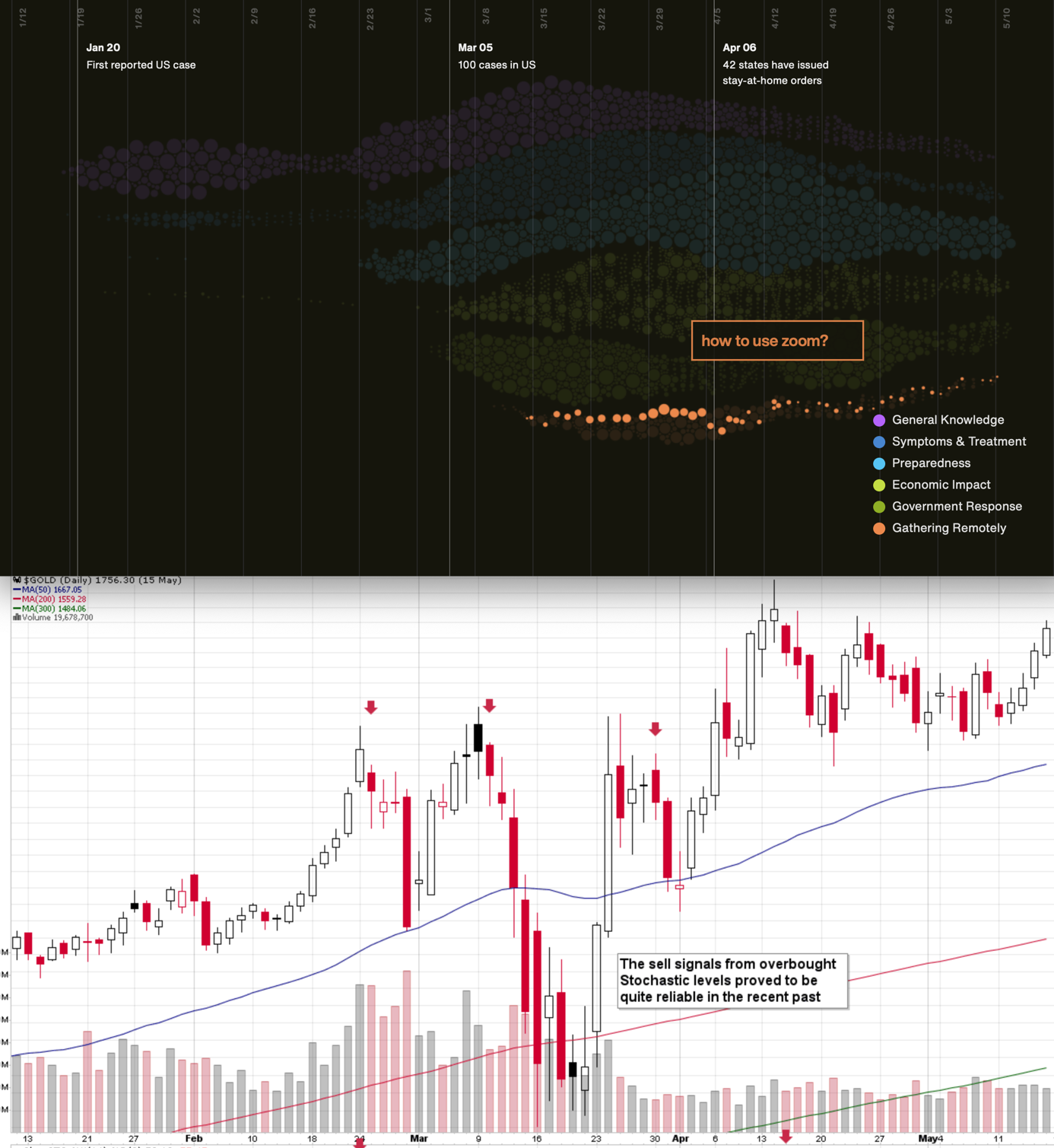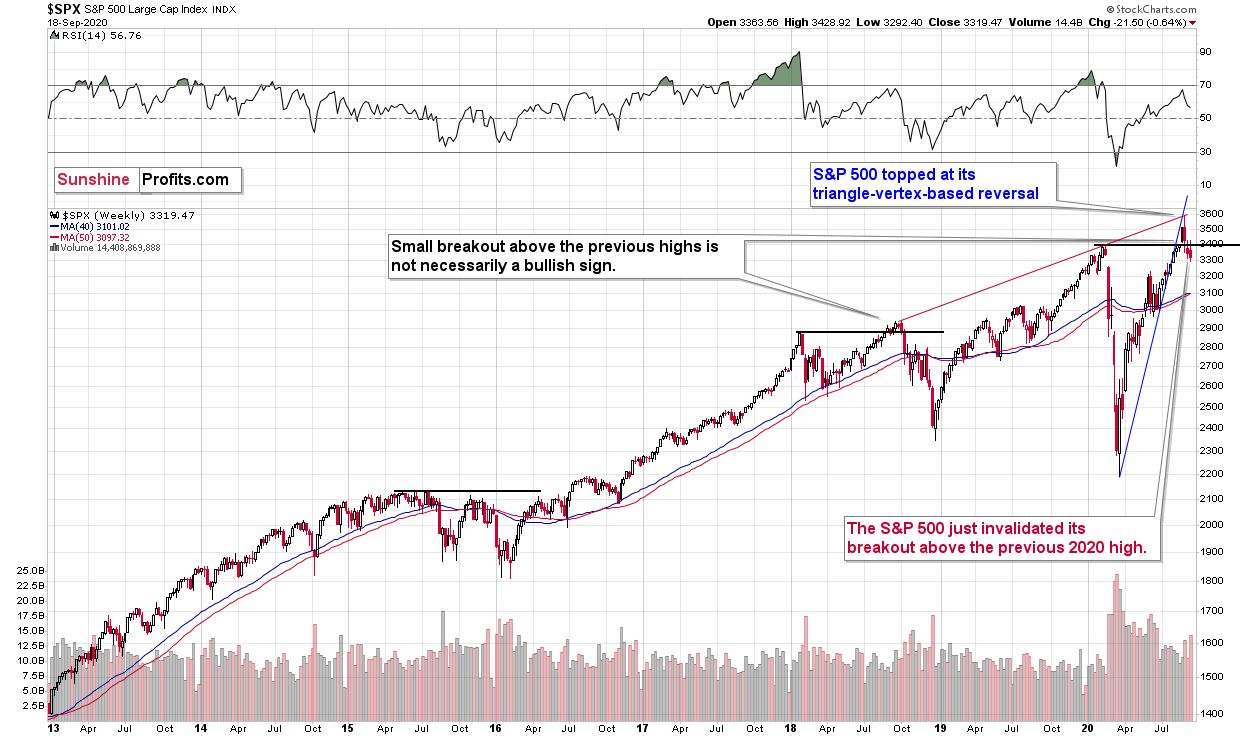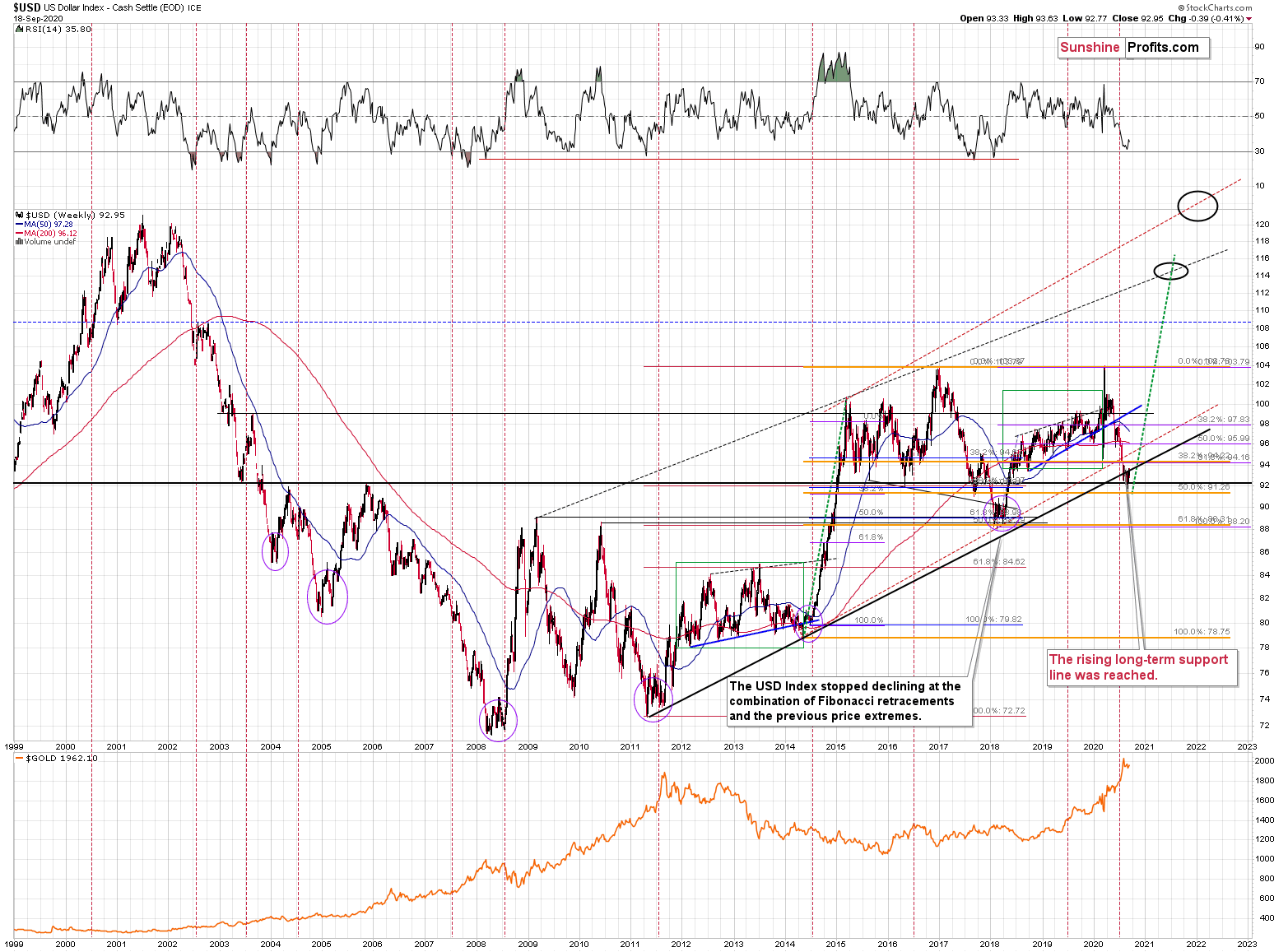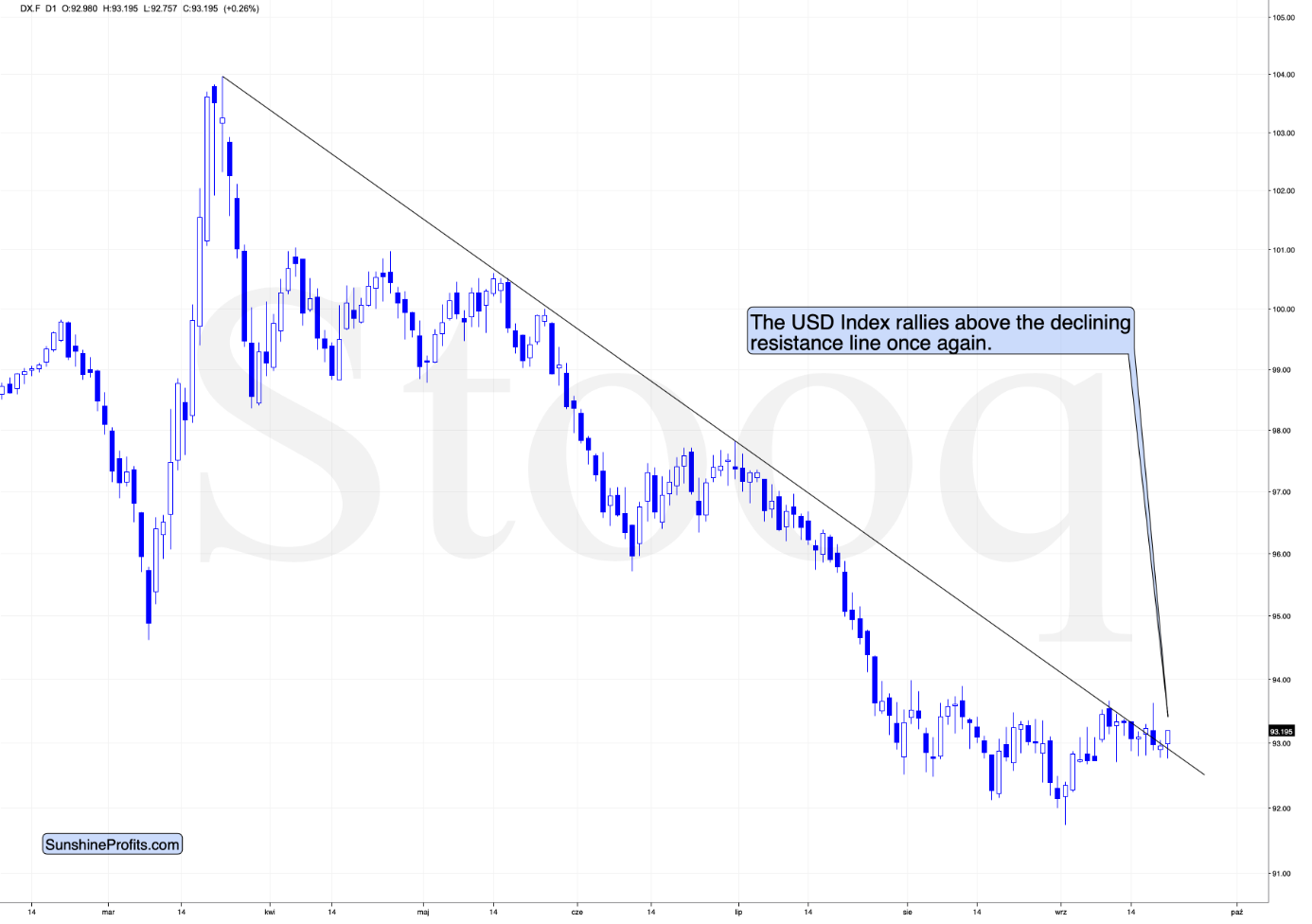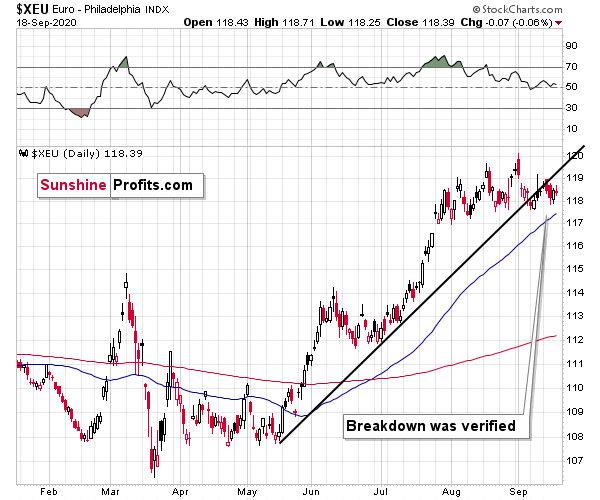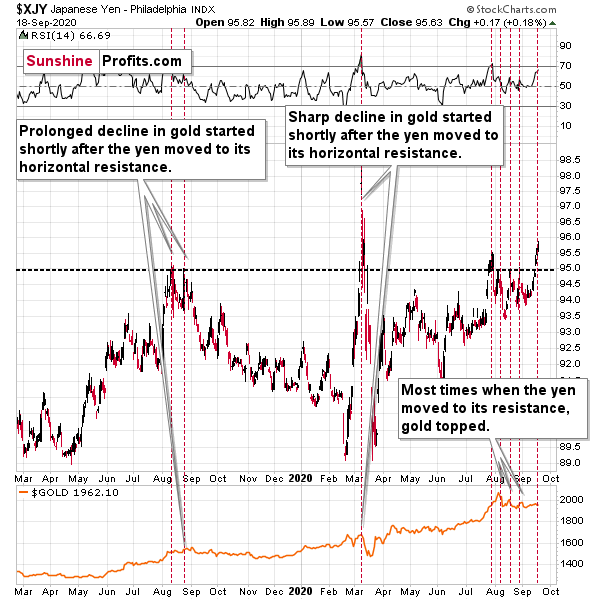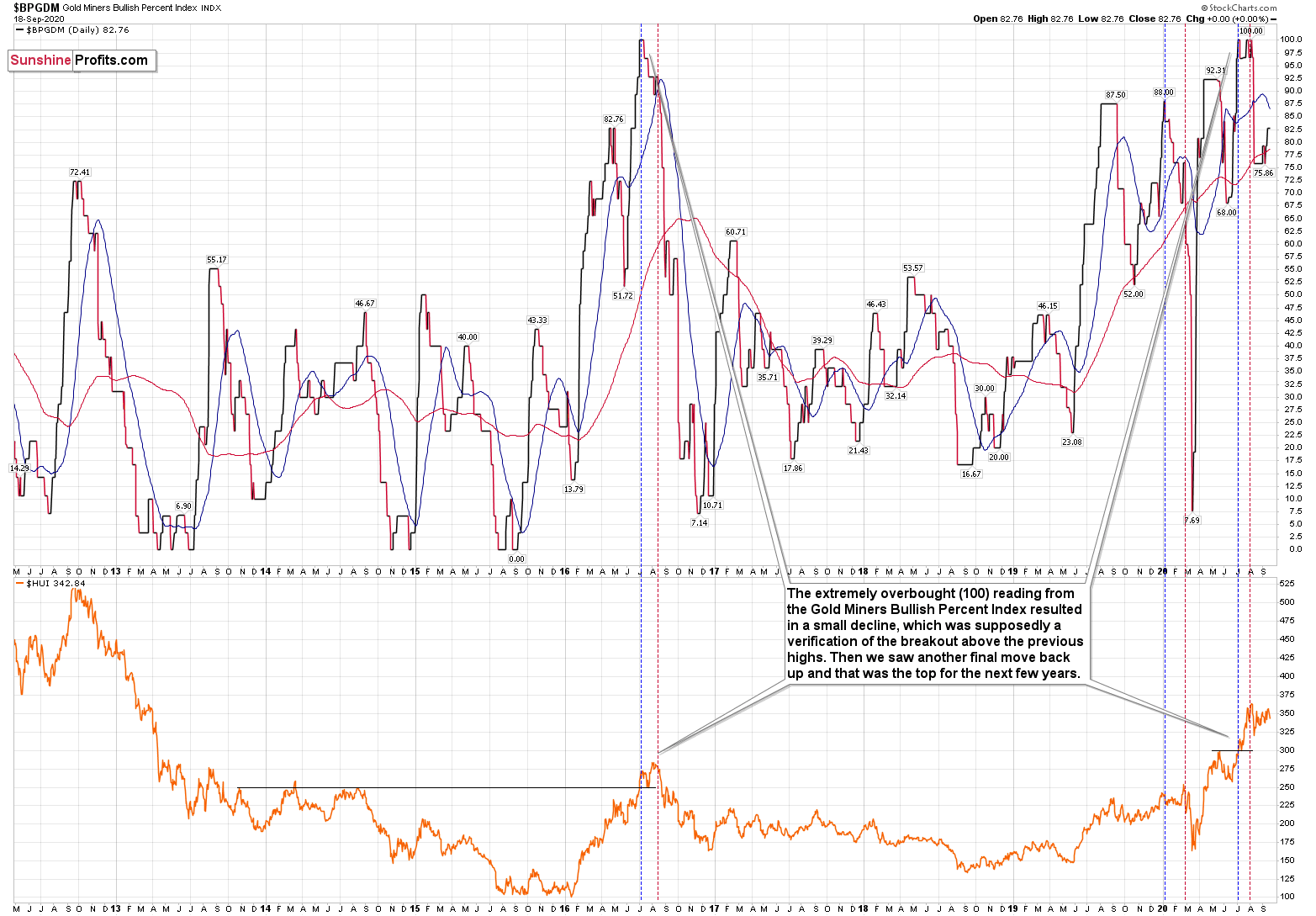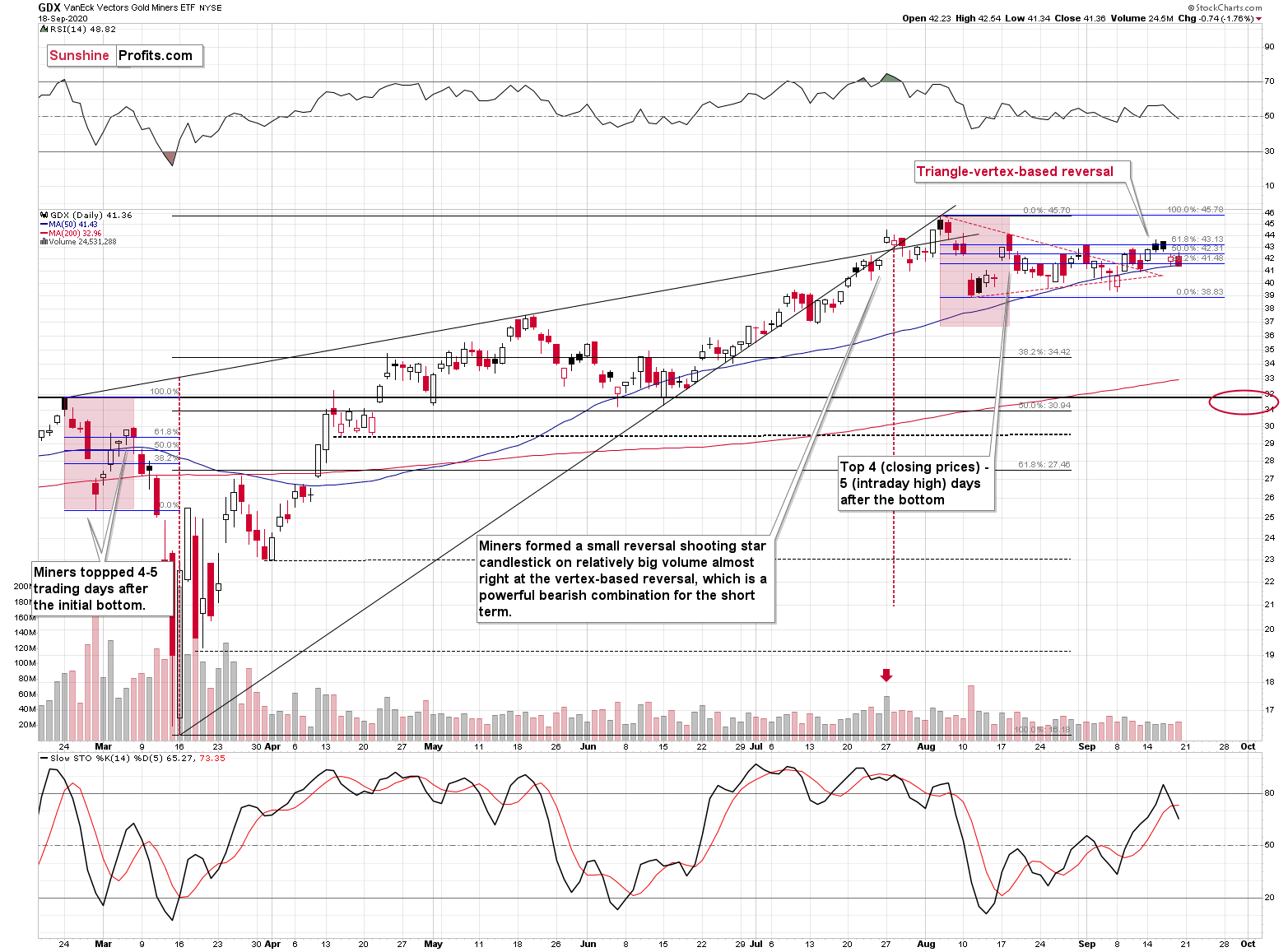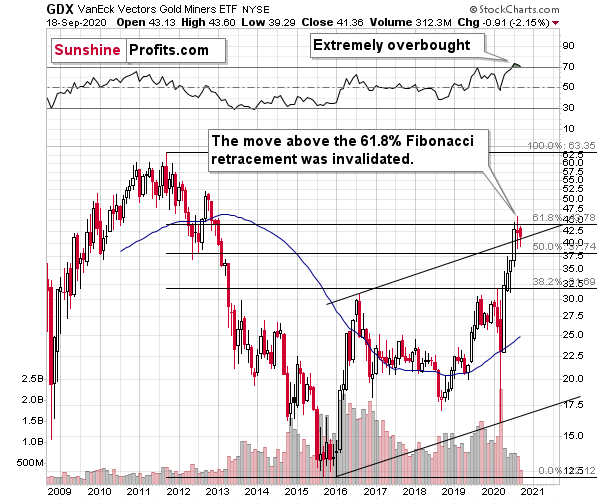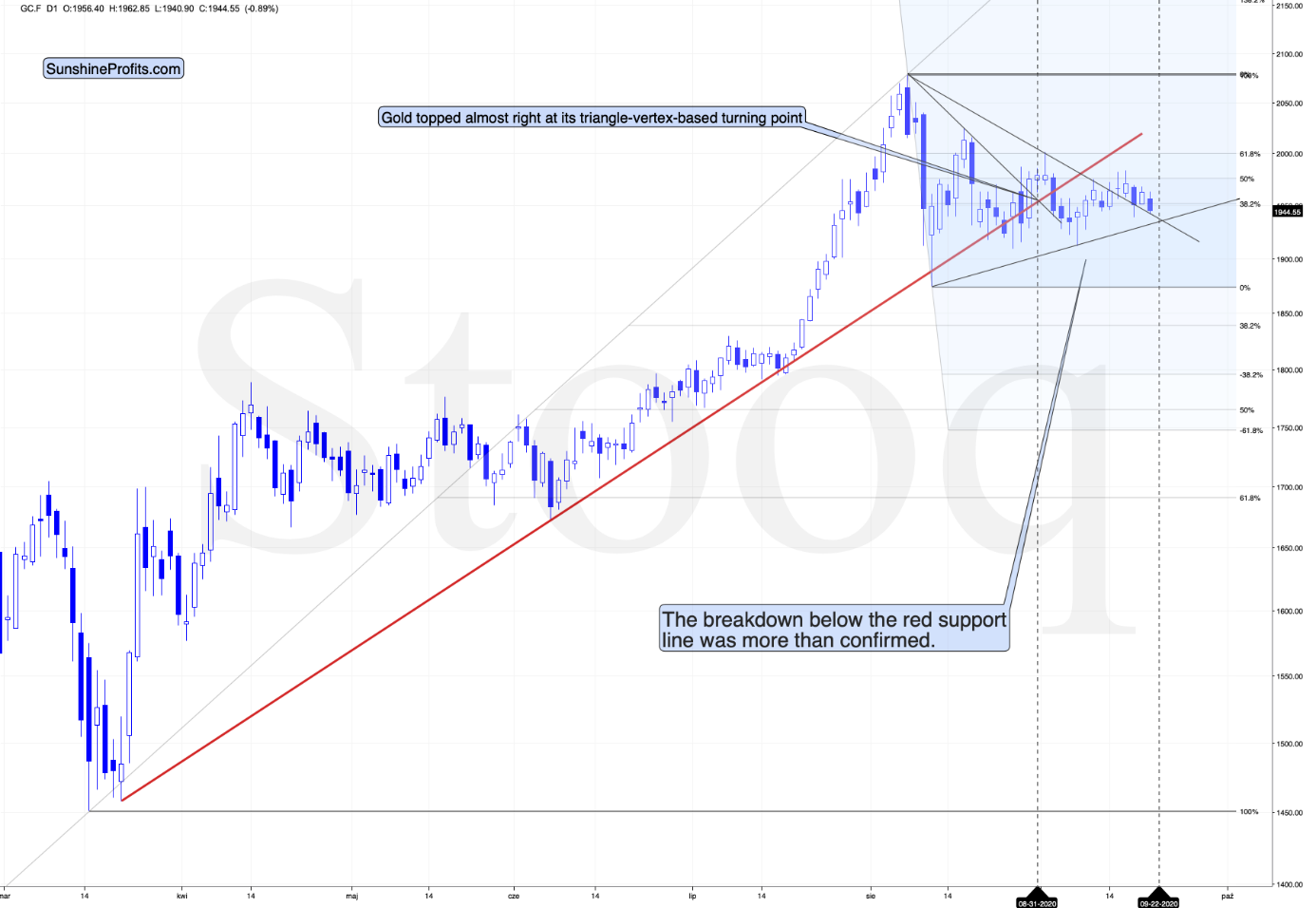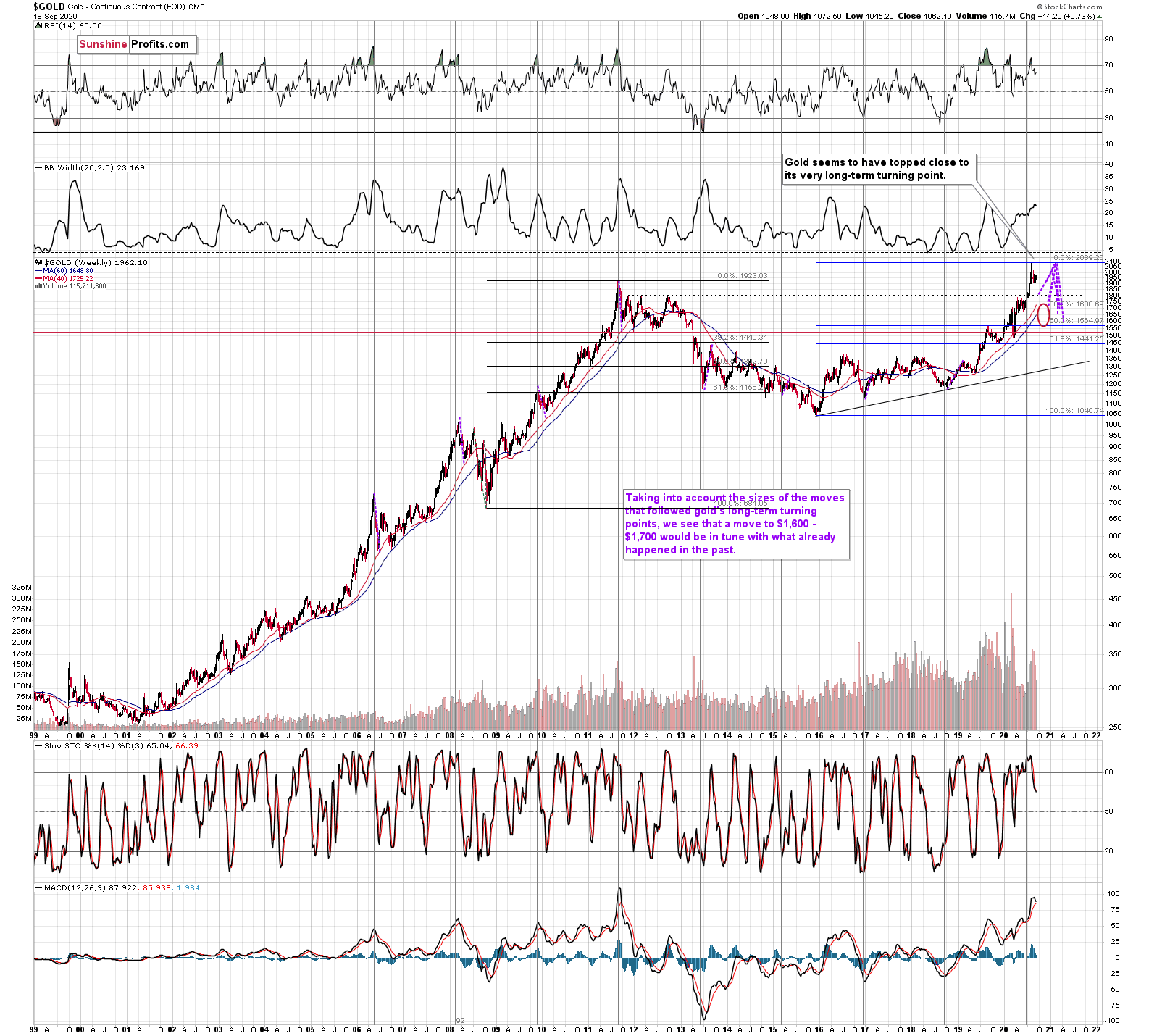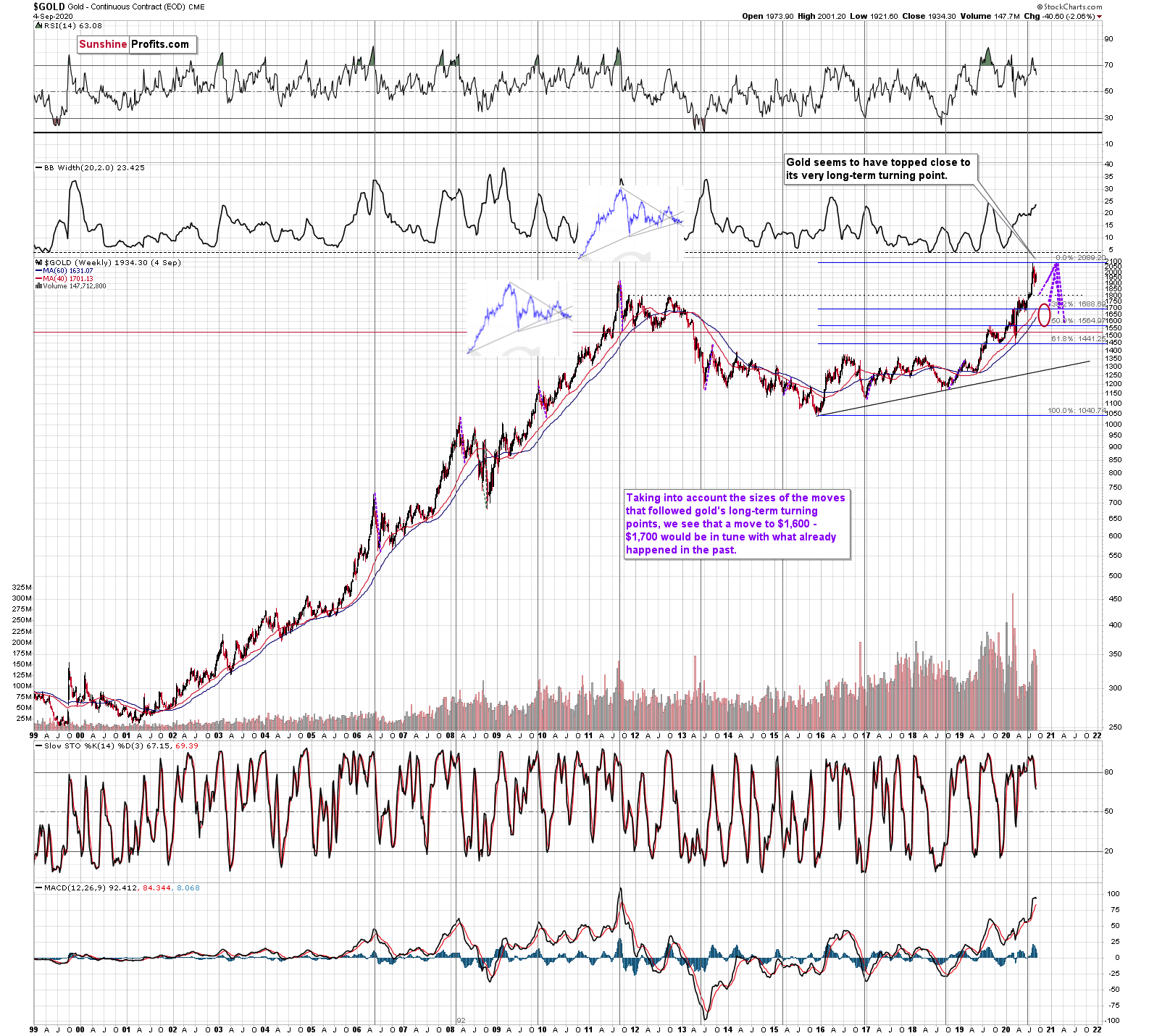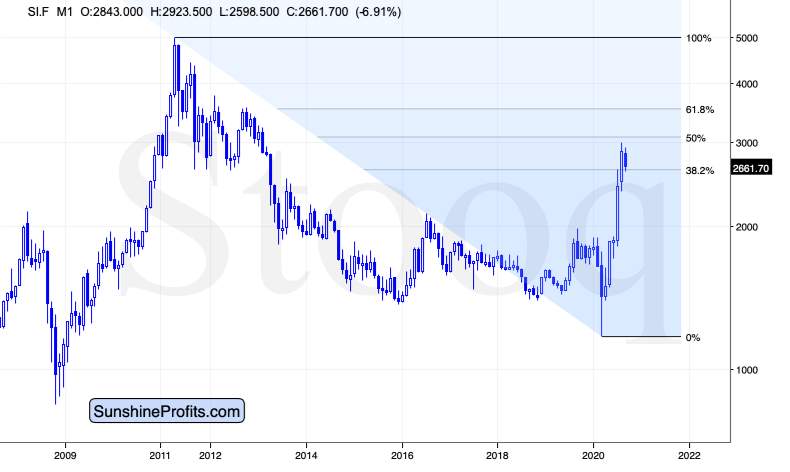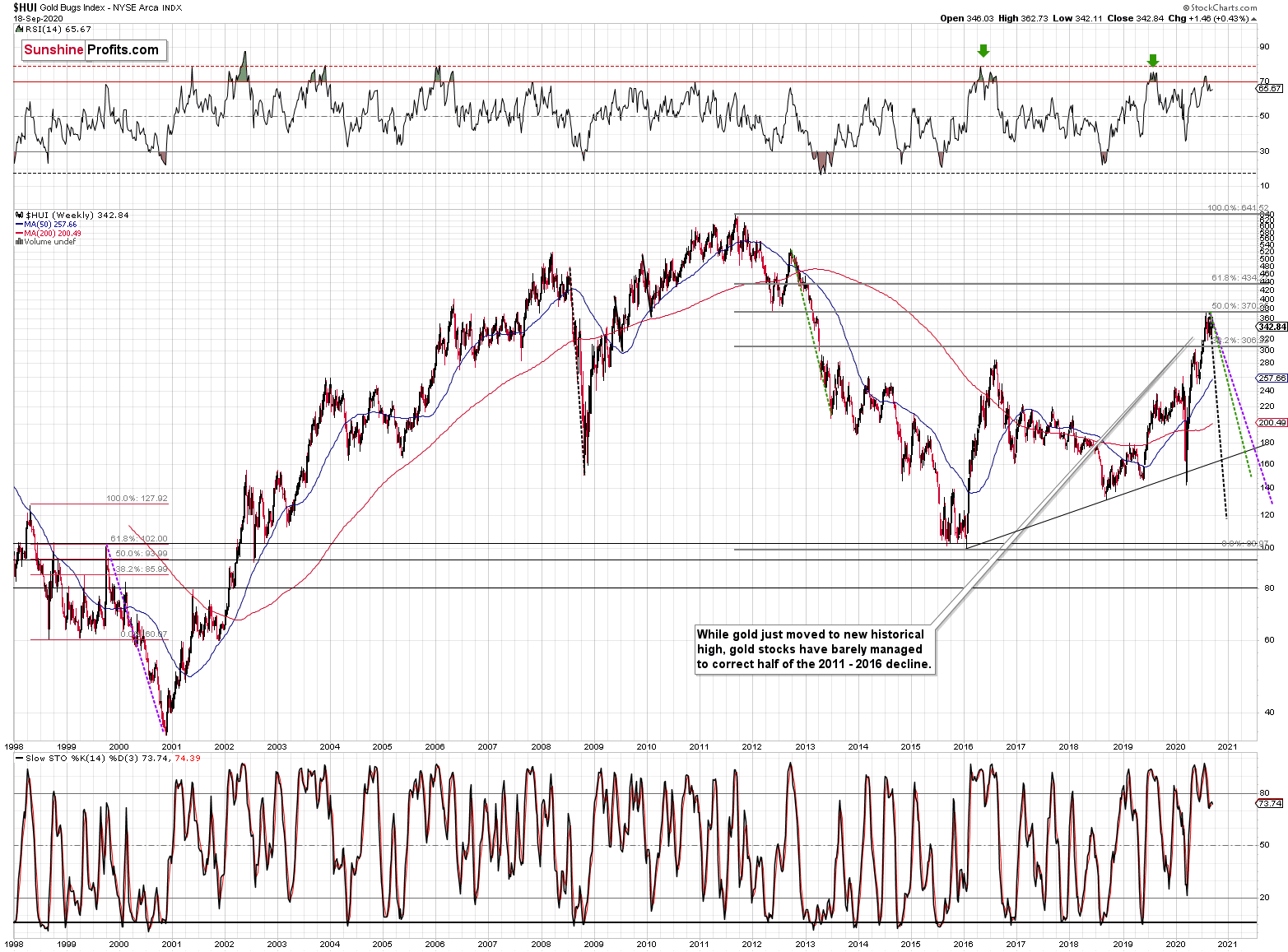Briefly: in our opinion, full (300% of the regular position size) speculative short positions in mining stocks are justified from the risk/reward point of view at the moment of publishing this Alert. We are moving back to our previous exposure given another breakout in the USD Index.
Welcome to this week's flagship Gold & Silver Trading Alert. As we promised you previously, in our flagship Alerts, we will be providing you with bigger, more complex analyses (approximately once per week) and it will usually take place on Monday.
The outlook that we featured latest, didn't change based on last week's price moves as prices generally moved in tune with our expectations. Consequently, there are parts of the previous analysis that didn't change in the previous days - we will put them in italics.
Before discussing the technical picture, we'd like to write a few words on the recent fundamental developments. As in the week before, we'll focus on the news coming from Europe. This time, we'll get back to the key topic not only in finance, but in general - the spread of the coronavirus.
The number of new daily infections in Europe is rapidly increasing, even reaching new heights in several countries. That is just another reminder that the second wave in fall or winter is upon us.
Yes, I know. You are all fed up reading about the coronavirus. And yet, the coronavirus is not fed up with spreading around the globe. The number of new daily infections keeps going up, as the chart below shows.
Most significantly, the coronavirus cases are in a dramatic rise across Europe. The weekly cases have now exceeded the reported levels when the pandemic first peaked in Europe back in March. Furthermore, the number of new daily infections has also reached record highs in several countries, such as Spain or France, as shown in the chart below.
Without a doubt, the improved testing procedures justify a segment of the infections' rise - but only a part. The death toll is now significantly lower than it was in spring, as the virus started spreading among the younger part of the population, while the healthcare systems are now better armed to handle the epidemic. But still, the WHO warns us that changes will happen as the winter approaches.
Therefore, if the virus became the new "normal" and people somehow stopped fearing it, that does not mean that the new virus stopped infecting people and influencing economies. Targeted lockdowns and restrictions are already returning across the continent to contain the spread of the coronavirus.
Hence, even though the gloomiest projections are not yet materialized, and the Fed even revised its economic growth forecast for 2020, the resurgence in new COVID-19 cases across Europe is a harsh reminder that the pandemic is not over yet. With that being said, in the upcoming months ahead, if the case count continues to rise worldwide, the global economic recovery could slow down.
Of course, there are reasons to be optimistic as well, as better therapeutics, rapid tests, and vaccines are on the horizon. However, the hopes that a Covid-19 vaccine will soon be widely available and solve all the problems are way too optimistic. As Sarah Zhang explains in "The Atlantic",
A vaccine, when it is available, will mark only the beginning of a long, slow ramp down. And how long that ramp down takes will depend on the efficacy of a vaccine, the success in delivering hundreds of millions of doses, and the willingness of people to get it at all.
Indeed, billions of vaccine production and distribution across the world will take months, if not years. Moreover, people may still refuse to get vaccinated, given the fact that 20 percent of Americans have already said that they will not take the vaccine, while another 30 percent is unsure, which indicates that the vaccine might not provide the society with the herd immunity.
What does it all imply for the gold market?
Well, the coronavirus no longer generates fears and panicking of massive magnitudes as it did in spring. Therefore, the rising number of cases in Europe doesn't significantly affect the price of gold. However, the resurgence of patients in Europe is a brutal reminder that the pandemic is not over yet and that the second wave is only a couple of months away.
On the other hand, let's keep in mind that when the precious metals market started to react to the coronavirus spread in March, it did so very rapidly. Perhaps we are not in this part of the price moves just yet.
Overall, the second wave would be positive for the gold prices (not necessarily immediately, though). However, it should include the US, as the resurgence in cases limited to Europe could strengthen the greenback against the euro and gold, neutralizing the increased safe-haven demand for the yellow metal.
If the second wave occurs, it should be bullish for gold not only because of the resulting economic slowdown and increased uncertainty but also because of the new stimulus programs that would probably be announced by both by the central banks and the governments.
You see, just like drug addicts are desperate for the next dose, the markets are always after more liquidity. It's enough to say that the recent dovish FOMC statement accompanied by fresh dot-plot and Powell's press conference was considered as disappointing by investors and not dovish enough. Both equities and gold declined in response to the Fed's announcement. This is because the central bank did not offer fresh policy measurements and did not expand its quantitative easing program.
But don't worry - a new stimulus is just a matter of time. The Fed may not care about the gold, but it won't leave Wall Street in need. Gold will benefit from such a noble heart of the American central bank.
All in all, there are multiple fundamental reasons due to which gold is likely to soar in the upcoming years, however, even the most profound bull markets can't move up in a straight line and some corrections will take place. After big rallies, we're likely to see big corrections, and one is long-overdue in case of the precious metals market.
Just as it was in March, it seems that the visible worsening in the economic situation might trigger a sell-off.
At this point we would like to quote what we wrote about the aspects of the virus scare and how the market reacts to them. In short, gold (and other markets) reacted when people started to strongly consider the economic implications and this topic was ubiquitous in the media.
The particularly important factor for gold will likely be the economic implications of the second Covid-19 wave. How do we know that? Because we compared what people were searching for (online) with how gold prices shaped. There's a lot more data available on https://searchingcovid19.com/ but we'll focus on the chart that shows when people were getting interested in what aspects of the pandemic and we'll compare them to gold.
We aligned both charts with regard to time. The chart on the bottom is from Stockcharts.com and it features gold's continuous futures contract. The gold price (and the USD Index value) really started to move once people got particularly interested in the economic impact of the pandemic and in the government's response.
In the recent days (and weeks) the news is dominated by other issues. Once people start considering the economic implications of the second wave of this coronavirus, the prices would be likely to move.
The news coming from the Fed is positive for gold in the long run, but in the short term, they continue to indicate risk for the economy. This risk is likely to translate into lower stock values and initially gold is likely to slide given the above - just like it did in March.
All in all, gold is likely to rally far in the long run, but in the short run it's vulnerable to a sizable decline, when the economic implications of the pandemic's continuation become obvious to investors.
Stocks and the Dollar Weigh In
Recently, the S&P 500 has moved sharply above its previous 2020 high, however, it has declined sharply again - shortly thereafter. Once the S&P reached the rising red resistance line, it turned south.
I previously wrote that the invalidation of the breakout would, be a clear bearish indication. And I think we'll see one soon - quite likely as the USD Index rallies.
That's exactly what happened. The S&P 500 ended the previous week lower, and it closed the week below the early-2020 high in weekly closing terms. And we just saw the second week with S&P 500 below its previous lows. This means that the breakout was invalidated in terms of: intraday prices, daily closing prices, and weekly closing prices. This is a bearish combination.
Do you remember what happened in February when the S&P 500 lost its upward momentum? Stocks plunged, and that was when tops in mining stocks and silver formed. Gold made another attempt to move higher but ultimately declined profoundly in the following days.
It appears that on one hand, everything that could have gone well for gold on the fundamental front, has already gone well, and it already rallied, and on the other hand, we have many signals pointing to the situation being excessive. This means that as some of the bullish factors ease (perhaps temporarily) and investors get scared about economy's ability to really recover, gold is likely to correct significantly, before continuing its upward march.
Speaking of indications pointing to the situation being excessive, let's take a look at the USD Index.
Remember when in early 2018 we wrote that the USD Index was bottoming due to a very powerful combination of support levels? Practically nobody wanted to read that as everyone "knew" that the USD Index is going to fall below 80. We were notified that people were hating on us in some blog comments for disclosing our opinion - that the USD Index was bottoming, and gold was topping. People were very unhappy with us writing that day after day, even though the USD Index refused to soar, and gold was not declining.
Well, it's the same right now.
The USD Index is at a powerful combination of support levels. One of them is the rising, long-term, black support line that's based on the 2011 and 2014 bottoms.
The other major, long-term factor is the proximity to the 92 level - that's when gold topped in 2004, 2005, and where it - approximately - bottomed in 2015, and 2016.
The USDX just moved to these profound support levels, and it's very oversold on a short-term basis. It all happened in the middle of the year, which is when the USDX formed major bottoms on many occasions. This makes a short-term rally here very likely.
While it might not be visible at the first sight (you can click on the chart to enlarge it), the USD Index moved briefly below the long-term, black support line and then it invalidated this breakdown before the end of the week. This is a very bullish indication for the next few weeks.
Based on the most recent price moves, the USDX is once again below the above-mentioned strong rising support line, but we doubt that this breakdown would hold. We expect to see an invalidation thereof that is followed by a rally.
Before moving to the short-term chart, please note that the major bottoms in the USD Index that formed in the middle of the previous years often took form of broad bottoms. Consequently, the current back and forth trading is not that surprising. This includes the 2008, 2011, and 2018 bottoms.
Shortly after invalidating its breakdown below the late-July lows, the USD Index broke above its declining short-term resistance line. It then consolidated and paused below the declining medium-term resistance line.
The above happened shortly after Fed announced a more dovish approach, which theoretically should have made the USD Index decline. This resilience was bullish, and it's something that suggests that the USD Index is about to break above the declining resistance line rather sooner than later.
And it would have all been nice and bullish, if the USD Index didn't invalidate its breakout last week. It did, and we even (temporarily) decreased the size of our short position in the precious metals market. Still, we wrote that the invalidation should not be trusted based on the situation in the two biggest components of the USD Index. Quoting our Friday's analysis:
The USDX was quite visibly above the declining resistance line, but it failed to hold these gains. Back in July, failure to rally above is resistance meant another big downturn, which translated into higher gold prices.
Does the same fate await the USD Index - and gold - in the near term?
Not necessarily.
The USD Index is a weighted average of several currency exchange rates. The biggest weight (over 50%) is attributed to the exchange rate with the euro, and the second biggest weight is attributed to the exchange rate with the yen. So, let's see how the situation looks like in both currencies.
The euro is after a breakdown and a verification thereof. This is a very bearish situation. That's bullish for the USD Index and - because of that - bearish for gold, at least in the short run.
What about the Japanese yen?
The situation is not that different as far as implications are concerned, but the direct reason for it, is.
As you can see on the above Japanese yen index chart, in the past 1.5 years, whenever it tried to rally above the 95 level, it topped shortly and reversed its course.
In mid-2019, this resulted in a prolonged decline in gold, and in early 2020, this resulted in a sharp and deep decline.
In the last few weeks, we saw this signal (the yen index trying to break above 95) 4 times: once it was a bit before the final top in gold, and in all the remaining (3) cases, these were local tops in gold.
The implications of the current situation in the yen are bearish for gold, and they are bullish for the USD Index, as the Japanese currency is likely to once again invalidated the breakout. The history tends to rhyme, after all.
Given the trading tips that the individual currency exchange rates give us, should we really expect the invalidation of the USD Index's breakout to lead to lower values? Not really. The individual currency exchange rates are more "basic" and their individual outlooks outweigh the index chart that is essentially based on them.
This means that the validity of the bearish implications of USDX's invalidation is suspicious, to say the least.
And indeed, the USD Index is rallying in today's pre-market trading. The move is not significant in terms of nominal price changes, but it is profound relative to the important resistance that its breaking. At the moment of writing these words, the USDX is after a visible breakout.
Of course, just as it was previously, the situation doesn't become crystal-bullish, unless we see a confirmation of the breakout in the form of either a significant move above the resistance (it's not significant so far), or three consecutive daily closes above it. Today would be the first such close (unless the breakout is invalidated on an intraday basis that is).
All in all, based on today's pre-market movement in the USDX, the situation in it is more bullish and more bearish for the PMs.
Back in March, the short-term breakout in the USD Index was the thing that triggered the powerful rally in it, as well as a powerful plunge in the precious metals market. It's generally a good gold trading tip to monitor the USD Index's performance.
Consequently, based on this analogy, the implications for the near term are bearish for the PMs. Especially, when we consider the fact that Gold Miners Bullish Percent Index showed the highest possible overbought reading recently.
The excessive bullishness was present at the 2016 top as well and it didn't cause the situation to be any less bearish in reality. All markets periodically get ahead of themselves regardless of how bullish the long-term outlook really is. Then, they correct. If the upswing was significant, the correction is also quite often significant.
Please note that back in 2016, there was an additional quick upswing before the slide and this additional upswing has caused the Gold Miners Bullish Percent Index to move up once again for a few days. It then declined once again. We saw something similar also this time. In this case, this move up took the index once again to the 100 level, while in 2016 this wasn't the case. But still, the similarity remains present.
Back in 2016, when we saw this phenomenon, it was already after the top, and right before the big decline. Given the situation in the USD Index, it seems that we're seeing the same thing also this time.
Please note that back in 2016, after the top, the buying opportunity didn't present itself until the Gold Miners Bullish Percent Index was below 10. It's currently above 70, so it seems that miners have a long way to go before they bottom (perhaps a few months - in analogy to how gold declined in 2016).
Four weeks ago, we commented on the above chart in the following way:
Now, since the general stock market moved above the previous highs and continues to rally, we might or might not see a sizable decline early this week. Back in March, the slide in miners corresponded to the decline in the general stock market, and this could be repeated, or we could see some sideways trading after the slide resumes, once stocks finally decline.
That's exactly what happened. The general stock market continued to move higher, and mining stocks have been trading sideways instead of declining - or rallying. Before miners' pause (and S&P's breakout) miners were repeating their late-February and early-March performance. The implications of the self-similar pattern were bearish, and they continue to be bearish, only the timing changed.
The GDX ETF didn't manage to break below the lower border of the triangle pattern yet, but given the situation in the USD Index and what we're about to show in you case of gold, it's likely that it will move lower shortly.
Instead, the GDX moved above the triangle pattern, and then it topped - no surprise here - at the triangle-vertex-based reversal (based on the triangle pattern that it had just broken above)
As the GDX seems to have topped, it looks as if it's finally ready to slide - mainly due to the general stock market closing below its early-2020 highs for two weeks in a row. In fact, both: S&P futures and gold futures are down in today's pre-market trading.
Also, let's not forget that the GDX ETF has recently invalidated the breakout above the 61.8% Fibonacci retracement based on the 2011 - 2016 decline.
When GDX approached its 38.2% Fibonacci retracement, it declined sharply - it was right after the 2016 top. Are we seeing the 2020 top right now? This is quite possible - PMs are likely to decline after the sharp upswing, and since there are only several months left before the year ends, it might be the case that they move north of the recent highs only in 2021.
Either way, miners' inability to move above the 61.8% Fibonacci retracement level and their invalidation of the tiny breakout is a bearish sign.
Let's proceed to metals themselves.
As far as gold is concerned, we previously wrote the following:
After topping at its triangle-vertex-based reversal, gold declined and is now trading at its declining resistance line, which turned into support. This could generate a rebound, especially that at the same time gold finally broke below the rising medium-term support line. This breakdown is a big deal, as all previous attempts were invalidated.
Since this support is so strong, we expect a rebound, quite possibly back to it. Such a verification (if gold doesn't invalidate the breakdown that is) would be very bearish for the short term.
Once again, we saw just that. Gold rallied one more time, but it managed to do so back above the previously broken resistance. Therefore, the breakdown was confirmed, and the outlook remains very bearish, especially given the indications from gold's long-term chart and its self-evident pattern.
The next support is at $1,700, where gold approximately topped and bottomed multiple times earlier this year. That's also the 61.8% Fibonacci retracement based on this year's upswing.
Please note that gold has yet another impending triangle-vertex-based reversal just a few days away (tomorrow or Wednesday). Given today's pre-market breakout in the USDX, it seems quite likely that gold would decline shortly and perhaps form a brief bottom tomorrow or on Wednesday, after which the slide would continue. Simultaneously, the USDX could be taking a breather, verifying the breakout in the process.
So far, 2020 has been an incredible and challenging year for the stock market, and that does not exclude gold, arguably one of the most important and most valuable commodities in the world. Predicting every short-term outlook of the precious metal market can always reveal new insights, especially when talking about gold.
The yellow metal's price is influenced by a myriad of obvious and non-obvious short and long-term factors, such as the long-term turning point and the self-similar pattern. In recent months, we've already discussed the presence of gold's long-term turning point in broad detail, and how the gold price situation is rather similar to what happened back in 2008. Furthermore, only a couple of weeks ago, we've learned a powerful self-similarity lesson from gold, making sense of similarly shaped patterns in the marketplace over different periods.
At the present moment, with yet another triangle-vertex-based reversal upon us and given the today's USDX pre-market breakout, gold's short decline is justified and will likely form a brief bottom, with the slide continuing afterward. Simultaneously, the USDX could be taking a breather, thus verifying its breakout:
The $1,700 level is additionally confirmed by the 38.2% Fibonacci retracement based on the entire 2015 - 2020 rally.
There's also possibility that gold would decline to the $1,500 - $1,600 area or so (50% Fibonacci retracement and the price level to which gold declined initially in 2011), but based on the size of the recent upswing, we no longer think that this scenario is the most likely one.
Gold's very long-term turning point is here and since the most recent move has definitely been to the upside, its implications are bearish.
We used the purple lines to mark the previous price moves that followed gold's long-term turning points, and we copied them to the current situation. We copied both the rallies and declines, which is why it seems that some moves would suggest that gold moves back in time - the point is to show how important the turning point is in general.
The big change here is that due to gold's big rally, we moved our downside target for it higher. Based on the information that we have available right now, it seems likely that gold will bottom close to the $1,700 level. That's very much in tune with how much gold moved after the previous long-term turning points.
Also, while we're discussing the long-term charts, please note the most important detail that you can see on the gold, silver, and mining stock charts, is hidden in plain sight. Please note how much silver and miners rallied.
The analogy to the price moves after the previous turning points didn't change, but since the starting point is much higher, the downside target is also higher.
Speaking of upside targets, four weeks ago, we wrote the following:
Based on gold's Fibonacci extensions and the previous major highs and lows (the 2018 high and late-2019 low along with the 2020 low), we get a nearby upside target of $2085. At the moment of writing these words, gold is trading at $2044. Given this week's volatility, it could even be a matter of hours before gold reaches the above-mentioned target and reverses. Taking closing prices into account, gold is up by $35, so if it reverses significantly, we would be likely to see a powerful weekly reversal candlestick and one that causes gold to decline in the following weeks.
That's more or less what happened. Gold topped at $2,089.20. It then declined quite visibly and closed last week at about $1,950.
Before moving to silver, we would like to discuss something very important regarding the most recent rally in gold and the subsequent consolidation.
Do you get the feeling that you have already seen gold perform this way before? Because you did.
The history rhymes, but this time, the similarity is quite shocking.
We copied the short-term chart and pasted it on the long-term chart above and next to the 2011 top. We pasted it twice, so that you can easily compare gold's performance in both cases in terms of both: price and time.
They are very similar to say the least. Yes, these patterns happened over different periods, but this doesn't matter. Markets are self-similar, which is why you can see similar short-term trends and long-term trends (with regard to their shapes). Consequently, comparing patterns of similar shape makes sense even if they form over different timeframes.
After a sharp rally, gold declined quickly. Then we saw a rebound, and a move back to the previous low. Then, after a bit longer time, gold moved close to the most recent high and started its final decline. This decline was less volatile than the initial slide. That's what happened when gold topped in 2011 (and in the following years), and that's what happened also this year. Ok, after the initial decline from the 2011 top, we saw two initial reactive rallies and in 2020 there was just one, but it didn't change the similarity with regard to time.
The patterns of this level of similarity are rare, and when they do finally take place, they tend to be remarkably precise with regard to the follow-up action.
What is likely to follow based on this pattern, is that we're likely to see the end of the slower decline, which will be followed by a big and sharp decline - similarly to what we saw in 2013.
How low could gold slide based on this similarity? Back in 2013, gold declined approximately to the 61.8% Fibonacci retracement based on the preceding rally (the one that started in 2008), so that's the natural target also this time.
And we already wrote about this particular retracement - it's approximately at the $1,700 level. This has been our downside target for weeks, and it was just confirmed by this precise self-similar technique.
Another interesting point is that gold made an interim low close to the 50% retracement and the previous lows. Applying this to the current situation suggests that we could see a smaller rebound when gold moves to about $1,760 - $1,800.
This might be the moment to switch from short positions in the miners to short position in silver. It's too early to say for sure at this time, though.
Speaking of silver, please note that from the long-term point of view, silver is not that strong.
While gold moved to new highs, silver - despite its powerful short-term upswing - didn't manage to correct more than half of its 2011 - 2020 decline.
We see something similar in the HUI Index. The latter corrected half of its 2011 - 2016 decline and nothing more, while gold moved well above its 2011 high.
All in all, it's mostly gold that is making the major gains - not the entire precious metals sector.
Overview of the Upcoming Decline
As far as the current overview of the upcoming decline is concerned, I think that it has already begun, at least in case of the mining stocks. It's still relatively unclear if gold makes another attempt to move to new highs before plunging below $1,800, but it now appears more likely that it won't.
During the final part of the slide (which could end later than in 6 weeks, perhaps very close to the end of the year - just like what happened in 2015), we expect silver to decline more than miners. That would be in tune with how the markets initially reacted to the Covid-19 threat.
The impact of all the new rounds of money printing in the U.S. and Europe on the precious metals prices is very positive in the long run, but it doesn't make the short-term decline unlikely. In the very near term, markets can and do get ahead of themselves and then need to decline - sometimes very profoundly - before continuing their upward march.
The plan is to exit the current positions in miners after they decline far and fast, but at the same time when silver declines just "significantly" (we expect this to happen in 0 - 6 weeks). In other words, the decline in silver should be severe, but the decline in the miners should look "ridiculous". That's what we did in March, when we bought practically right at the bottom. This is a very soft and broad instruction, so additional confirmations are necessary. I expect this confirmation to come from gold reaching about $1,800. If - at the same time - gold moves to about $1,800 and miners are already after a ridiculously big drop (say, to $31 - $32 in the GDX ETF - or lower), we will probably exit the short positions in the miners and at the same time enter short positions in silver. It will be tempting to wait with opening the short position in silver until the entire sector rebounds, but such a rebound could last only a couple of hours, so it would be very difficult to execute such strategy successfully.
Summary
Summing up, it seems that after reversing $4 above our upside target, gold has finally topped, and that it formed the second top from the double-top pattern in mid-August. The USD Index appears to be forming a broad bottom, just like it did in 2008, 2011, and 2018. It's worth keeping in mind that while the USDX just moved slightly below its recent lows, gold didn't move to its recent highs. This relative underperformance, along with the specific juncture at which the USD Index currently is, creates a very bearish environment for the precious metals market, especially for the mining stocks. The decline in the latter is likely to accelerate once the general stock market finally moves down.
The self-similar pattern in gold makes the outlook even more bearish and it adds to the already bearish outlook for the next several weeks.
Naturally, everyone's trading is their responsibility, but in our opinion, if there ever was a time to either enter a short position in the miners or to increase its size if it wasn't already sizable, it's now. We made money on the March decline and on the March rebound, and it seems that another massive slide is about to start. When everyone is on one side of the boat, it's a good idea to be on the other side, and the Gold Miners Bullish Percent Index literally indicates that this is the case with mining stocks.
After the sell-off (that takes gold to about $1,700 or lower), we expect the precious metals to rally significantly. The final decline might take as little as 1-6 weeks, so it's important to stay alert to any changes.
Most importantly - stay healthy and safe. We made a lot of money on the March decline and the subsequent rebound (its initial part) price moves (and we'll likely make much more in the following weeks and months), but you have to be healthy to really enjoy the results.
As always, we'll keep you - our subscribers - informed.
To summarize:
Trading capital (supplementary part of the portfolio; our opinion): Full speculative short positions (300% of the full position) in mining stocks is justified from the risk to reward point of view with the following binding exit profit-take price levels:
Senior mining stocks (price levels for the GDX ETF): binding profit-take exit price: $32.02; stop-loss: none (the volatility is too big to justify a SL order in case of this particular trade); binding profit-take level for the DUST ETF: $28.73; stop-loss for the DUST ETF: none (the volatility is too big to justify a SL order in case of this particular trade)
Junior mining stocks (price levels for the GDXJ ETF): binding profit-take exit price: $42.72; stop-loss: none (the volatility is too big to justify a SL order in case of this particular trade); binding profit-take level for the JDST ETF: $21.22; stop-loss for the JDST ETF: none (the volatility is too big to justify a SL order in case of this particular trade)
For-your-information targets (our opinion; we continue to think that mining stocks are the preferred way of taking advantage of the upcoming price move, but if for whatever reason one wants / has to use silver or gold for this trade, we are providing the details anyway. In our view, silver has greater potential than gold does):
Silver futures downside profit-take exit price: unclear at this time - initially, it might be a good idea to exit, when gold moves to $1,703.
Gold futures downside profit-take exit price: $1,703
Long-term capital (core part of the portfolio; our opinion): No positions (in other words: cash
Insurance capital (core part of the portfolio; our opinion): Full position
Whether you already subscribed or not, we encourage you to find out how to make the most of our alerts and read our replies to the most common alert-and-gold-trading-related-questions.
Please note that the in the trading section we describe the situation for the day that the alert is posted. In other words, it we are writing about a speculative position, it means that it is up-to-date on the day it was posted. We are also featuring the initial target prices, so that you can decide whether keeping a position on a given day is something that is in tune with your approach (some moves are too small for medium-term traders and some might appear too big for day-traders).
Plus, you might want to read why our stop-loss orders are usually relatively far from the current price.
Please note that a full position doesn't mean using all of the capital for a given trade. You will find details on our thoughts on gold portfolio structuring in the Key Insights section on our website.
As a reminder - "initial target price" means exactly that - an "initial" one, it's not a price level at which we suggest closing positions. If this becomes the case (like it did in the previous trade) we will refer to these levels as levels of exit orders (exactly as we've done previously). Stop-loss levels, however, are naturally not "initial", but something that, in our opinion, might be entered as an order.
Since it is impossible to synchronize target prices and stop-loss levels for all the ETFs and ETNs with the main markets that we provide these levels for (gold, silver and mining stocks - the GDX ETF), the stop-loss levels and target prices for other ETNs and ETF (among other: UGLD, DGLD, USLV, DSLV, NUGT, DUST, JNUG, JDST) are provided as supplementary, and not as "final". This means that if a stop-loss or a target level is reached for any of the "additional instruments" (DGLD for instance), but not for the "main instrument" (gold in this case), we will view positions in both gold and DGLD as still open and the stop-loss for DGLD would have to be moved lower. On the other hand, if gold moves to a stop-loss level but DGLD doesn't, then we will view both positions (in gold and DGLD) as closed. In other words, since it's not possible to be 100% certain that each related instrument moves to a given level when the underlying instrument does, we can't provide levels that would be binding. The levels that we do provide are our best estimate of the levels that will correspond to the levels in the underlying assets, but it will be the underlying assets that one will need to focus on regarding the signs pointing to closing a given position or keeping it open. We might adjust the levels in the "additional instruments" without adjusting the levels in the "main instruments", which will simply mean that we have improved our estimation of these levels, not that we changed our outlook on the markets. We are already working on a tool that would update these levels on a daily basis for the most popular ETFs, ETNs and individual mining stocks.
Our preferred ways to invest in and to trade gold along with the reasoning can be found in the how to buy gold section. Additionally, our preferred ETFs and ETNs can be found in our Gold & Silver ETF Ranking.
As a reminder, Gold & Silver Trading Alerts are posted before or on each trading day (we usually post them before the opening bell, but we don't promise doing that each day). If there's anything urgent, we will send you an additional small alert before posting the main one.
Thank you.
Sincerely,
Przemyslaw Radomski, CFA
Editor-in-chief, Gold & Silver Fund Manager


